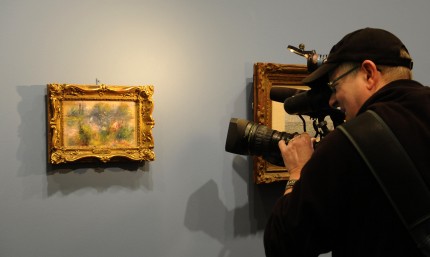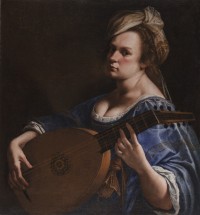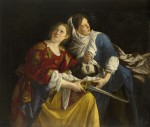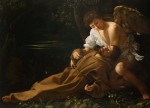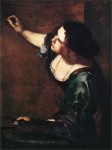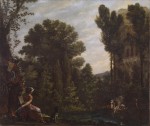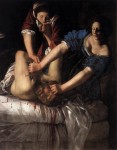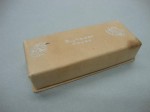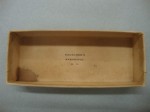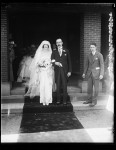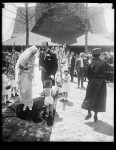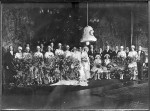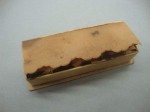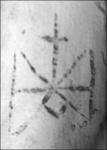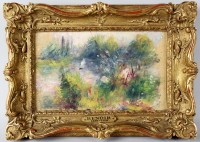 Sixty-two years after it was stolen from the Baltimore Museum of Art, Renoir’s Paysage Bords de Seine is once again on display in the museum’s galleries. The little 5 1/2″-by-9″ landscape, reputedly painted by the Impressionist master for his mistress on a linen napkin at a cafe on the shores of the Seine in 1879, first made the news in 2012 when it was put up for auction by a woman (later revealed to be one Marcia “Martha” Fuqua) who claimed she bought it at a flea market for $7 in a box lot along with a plastic cow and a Paul Bunyan doll. That story soon turned out to have more than a few gaping holes which were exposed when a Washington Post reporter discovered evidence in the archives of the Baltimore Museum of Art that the painting had been stolen from the museum on November 17th, 1951.
Sixty-two years after it was stolen from the Baltimore Museum of Art, Renoir’s Paysage Bords de Seine is once again on display in the museum’s galleries. The little 5 1/2″-by-9″ landscape, reputedly painted by the Impressionist master for his mistress on a linen napkin at a cafe on the shores of the Seine in 1879, first made the news in 2012 when it was put up for auction by a woman (later revealed to be one Marcia “Martha” Fuqua) who claimed she bought it at a flea market for $7 in a box lot along with a plastic cow and a Paul Bunyan doll. That story soon turned out to have more than a few gaping holes which were exposed when a Washington Post reporter discovered evidence in the archives of the Baltimore Museum of Art that the painting had been stolen from the museum on November 17th, 1951.
The sale was canceled while a federal court decided who owned legal title to the painting. Possible contenders were the museum, Fuqua and the Fireman’s Fund Insurance Company which had paid the museum $2,500 after the theft. The insurance company declined to pursue their own claim because they believed that the Renoir should return to the Baltimore Museum of Art. In January, the court decided that even if Fuqua was an “innocent owner” who had no idea the painting was stolen when she acquired it, a thief cannot pass title to a new owner, innocent or otherwise. The landscape was going back to the museum.
 Since then, BMA conservators have treated the work — it was in excellent condition and only needed a surface cleaning — to prepare it for its triumphant return. On March 30th, The Renoir Returns exhibition opened to the general public. Paysage Bords de Seine is on display with more than 20 other important pieces bequeathed to the museum by collector and benefactor Saidie Adler May. A dedicated collector of Impressionist and early 20th century art, Saidie Adler May left her entire collection to the Baltimore Museum of Art, but this is the first time, believe it or not, that the museum has dedicated an exhibition to Saidie May’s donations. Works from the May collection by Mondrian, Klee and Miró join the Renoir in the two-gallery show. May’s own artwork also gets display space next to the masterworks.
Since then, BMA conservators have treated the work — it was in excellent condition and only needed a surface cleaning — to prepare it for its triumphant return. On March 30th, The Renoir Returns exhibition opened to the general public. Paysage Bords de Seine is on display with more than 20 other important pieces bequeathed to the museum by collector and benefactor Saidie Adler May. A dedicated collector of Impressionist and early 20th century art, Saidie Adler May left her entire collection to the Baltimore Museum of Art, but this is the first time, believe it or not, that the museum has dedicated an exhibition to Saidie May’s donations. Works from the May collection by Mondrian, Klee and Miró join the Renoir in the two-gallery show. May’s own artwork also gets display space next to the masterworks.
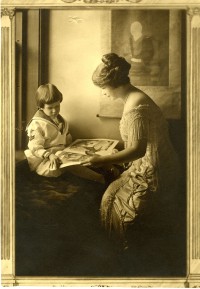 Earlier articles said that according the records of the Bernheim-Jeune gallery in Paris, the painting was purchased by Herbert L. May, Saidie’s estranged husband, in 1926. According to the BMA’s press release about the exhibition, however, Saidie and Herbert bought the painting together in November of 1925. Museum researchers discovered a diary in which she wrote about her acquisition of the Renoir. She bought it from Bernheim-Jeune along with an oil sketch by Georges Seurat, paying $2,000 for both. The diary entry and the original receipt of the purchase are part of the exhibition, as is the Seurat.
Earlier articles said that according the records of the Bernheim-Jeune gallery in Paris, the painting was purchased by Herbert L. May, Saidie’s estranged husband, in 1926. According to the BMA’s press release about the exhibition, however, Saidie and Herbert bought the painting together in November of 1925. Museum researchers discovered a diary in which she wrote about her acquisition of the Renoir. She bought it from Bernheim-Jeune along with an oil sketch by Georges Seurat, paying $2,000 for both. The diary entry and the original receipt of the purchase are part of the exhibition, as is the Seurat.
Researchers also found evidence supporting the linen napkin story.
New research conducted by the BMA’s conservation and textile departments confirms part of Saidie May’s story about Renoir painting the landscape on a linen napkin at a restaurant on the Seine for his mistress. Since Renoir was not married at the time, there is no conclusive information about the identity of his mistress, but the surface of the painting is in fact a linen damask with an elaborate geometric weave. It was unusual for painters to use this type of fabric as a background, but very common for table linens of that period. It turns out to have been a good choice, as linen increases in strength when wet and is smoother than wool and cotton.
As for what happened to the painting between 1951 and 2012, it doesn’t look like we’ll be getting answers any time soon. The FBI has closed its investigation because they don’t have enough evidence to arrest someone for the theft or even for knowingly possessing stolen goods. There are too many contradictory stories to pin anything on anyone.
 One key witness, and possible suspect, was Martha Fuqua’s mother Marcia Fouquet. She was an art student in Baltimore in 1951 and had at least one friend who worked at the museum. Borders and family, including her son Matt, recall seeing the painting in her home in the 80s and 90s. The FBI did interview her before her death in September of 2013, but didn’t actually ask her if she was involved in the theft or even if she had the painting hanging in her home. Special agent in charge of the investigation Gregg Horner says: “I did not ask her about the Renoir. I did not feel that the timing was right. She’s a very interesting lady, very well-educated. We had a nice, pleasant conversation. I talked to her in general terms about her art.” He never followed up with her because of her precipitous decline in health (she was 85 years old and had cancer). “Given her illness,” Horner said, “I didn’t think it was appropriate.”
One key witness, and possible suspect, was Martha Fuqua’s mother Marcia Fouquet. She was an art student in Baltimore in 1951 and had at least one friend who worked at the museum. Borders and family, including her son Matt, recall seeing the painting in her home in the 80s and 90s. The FBI did interview her before her death in September of 2013, but didn’t actually ask her if she was involved in the theft or even if she had the painting hanging in her home. Special agent in charge of the investigation Gregg Horner says: “I did not ask her about the Renoir. I did not feel that the timing was right. She’s a very interesting lady, very well-educated. We had a nice, pleasant conversation. I talked to her in general terms about her art.” He never followed up with her because of her precipitous decline in health (she was 85 years old and had cancer). “Given her illness,” Horner said, “I didn’t think it was appropriate.”
I am completely perplexed by this. It’s not idle curiosity, after all. He’s an agent investigating a crime. What is the point of interviewing a witness/suspect IF YOU DON’T ASK THEM ABOUT THE CRIME? I mean, a pleasant conversation about her art? Bizarre.
Anyway, there’s a silver lining to the theft, because now there’s this crazy adventure to add to the history of the painting and the museum is poised to take full advantage of the little landscape’s new notoriety (don’t forget to buy the magnet at the gift shop!). It’s also brought Saidie Adler May’s invaluable contributions some well-deserved and belated recognition. The Renoir Returns runs through July 20, 2014.
